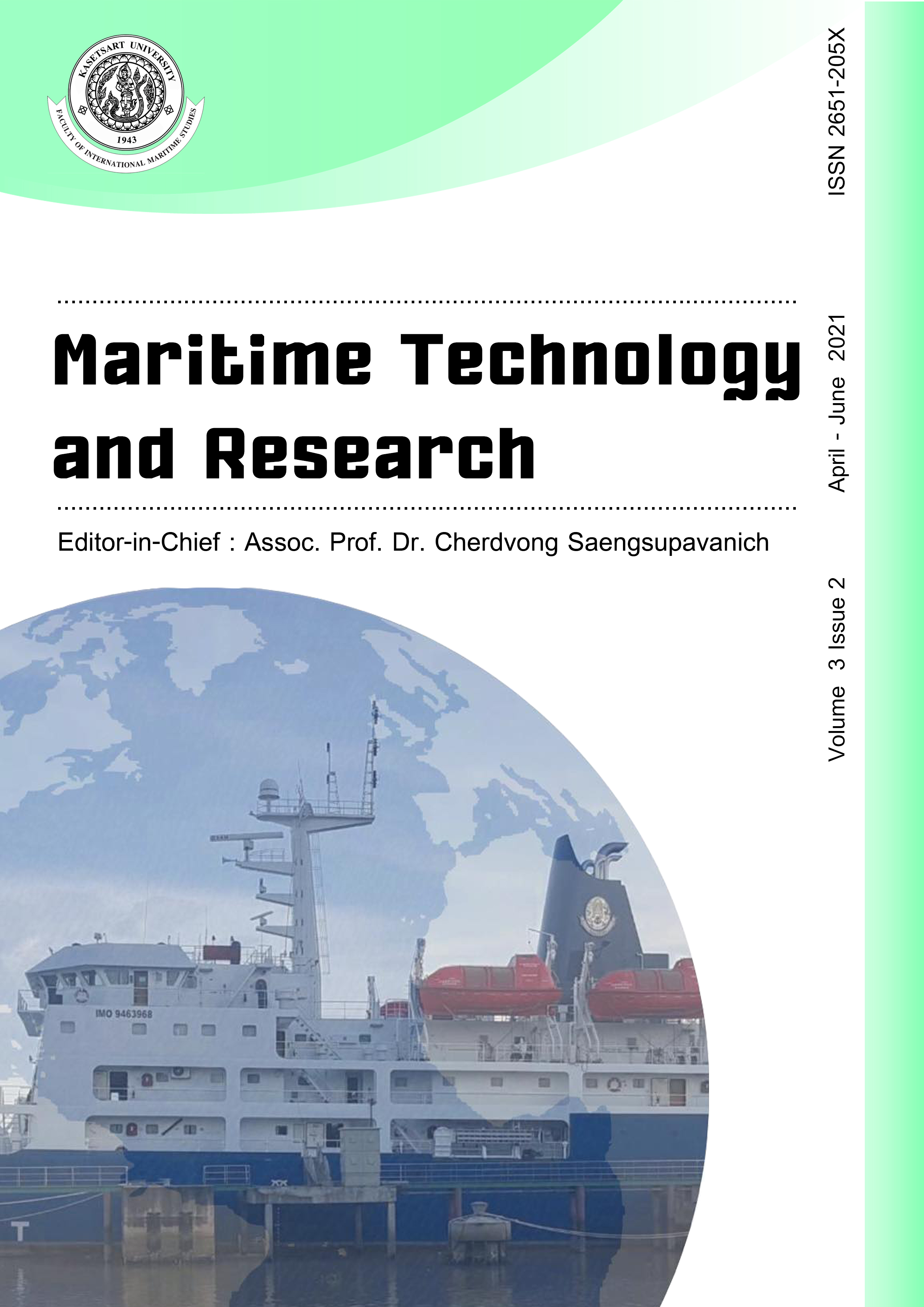Determining the loss of efficiency of twin propeller systems in circulation maneuvers
DOI:
https://doi.org/10.33175/mtr.2021.244703Keywords:
Twin screw, Asymmetric efficiency, Manoeuvring, Interaction coefficients, Thrust, TorqueAbstract
Nowadays, a large number of newly-built inland and navy vessels are equipped with a twin propeller-twin rudder configuration (TPTR). Observations of units of TPTR systems when performing maneuvers at curvilinear trajectories show asymmetrical loading. The nature and parameters of the phenomenon have not been sufficiently studied, in which specific maneuvers could lead to overloading and loss of effectiveness. The purpose of this paper is to study the effectiveness of a ship’s TP system in maneuvering, taking into account the influence of the oblique flow to the “internal” and “external” propellers respective to the trajectory of motion. Appropriate maneuvering experiments with a free-running ship model are carried out, by which the propeller thrust and torque are measured. Based on the obtained investigation results, analyses of interaction effects in the TP system are performed. Coefficients for estimating the asymmetric efficiency of the twin-screw system are developed, and related conclusions are summarized.
References
ANEP-70 Volume I. (2003). Guidance for naval surface ships mission oriented manoeuvring requirements. NATO Allied Naval Engineering Publication 70.
Basin, A. M. (1977). Propulsion and handling of ships (in Russian). Moscow, Transport.
Coraddu, A., Dubbioso, G., Mauro, S., & Viviani, M. (2013). Analysis of twin screw ships asymmetric propeller behaviour by means of free running model tests. Ocean Engineering, 68, 47-64. doi:10.1016/j.oceaneng.2013.04.013
Dubbioso, G., & Viviani, M. (2012a). Aspects of twin screw ships semi-empirical manoeuvring models. Ocean Engineering, 48, 69-80. doi:10.1016/j.oceaneng.2012.03.007
Dubbioso, G., & Viviani, M. (2012b). Experimental investigation of asymmetrical propeller behaviour of twin screw ships during manoeuvres. In Proceedings of the International Conference on Marine Simulation and Ship Maneuverability 2012. Singapore.
Dubbioso, G., Mauro, S., & Viviani, M. (2011). Off-design propulsion power plant investigations by means of free running manoeuvring ship model test and simulation techniques. In Proceedings of the 21st International Offshore and Polar Engineering Conference. Hawaii, USA.
Efremov, D. (2015). Simulation model of the “Main Engine-Hull-Propeller” system dynamics in ship manoeuvring motion (in Bulgarian). Ph.D. Thesis, Bulgarian Ship Hydrodynamics Centre, Bulgarian Academy of Sciences.
Efremov, D. (2016). Experimental investigation of asymmetric behavior of propeller shafts during maneuvering of twin screw ship. Engineering Sciences, 63, 63-77.
Efremov, D., & Milanov, E. (2017). Investigation of twin-rudder load asymmetric behaviour by free-running model tests. In Proceedings of the 21st International Conference on Hydrodynamics in Ship Design and Operation. Gdansk, Poland.
Fedyaevsky, K. K., & Sobolev, V. G. (1963). Ship handling (in Russian), Sudpromgiz.
Fossen, T. I. (2005). A nonlinear unified state-space model for ship maneuvering and control in a seaway. International Journal of Bifurcation and Chaos, 15(9), 2717-2746. doi:10.1142/S0218127405013691
Goffman, A. D. (1988). Propulsion and steering complex and manoeuvring the vessel (in Russian). Shipbuilding, Leningrad.
Goodman, A., Gertler, M., & Kohl, R. (1976). Experimental techniques and methods of analysis used at hydronautics for surface: Ship maneuvering prediction. In Proceedings of the 11th Symposium on Naval Hydrodynamics. London.
Gutshe, F. (1964). Untersuchungen Schiffsschrauben in schräger Ausstromung (in Russian), Schiffbauforschung.
Khanfir, S., Hasegawa, K., Kobayashi, E., & Nagarajan, V. (2012). Mathematical model for manoeuvring of twin-propeller twin-rudder ship considering peculiar rudder normal force phenomenon. In Proceedings of the International Conference on Marine Simulation and Ship Maneuverability 2012. Singapore.
Molland, A. F., & Turnock, S. R. (2007). Marine rudders and control surfaces. Elsevier, London, UK. doi:10.1016/B978-0-7506-6944-3.X5000-8
Ortolani, F., Viviani, M., Tani, G., & Dubbioso, G. (2020). Experimental investigation of single blade loads by captive model tests in pure oblique flow. Ocean Engineering, 196, 106789. doi:10.1016/j.oceaneng.2019.106789
Vasiliev, A. V. (1989). Ship handling (in Russian). Shipbuilding, Leningrad.
Viviani, M., Bonvino, C., Mauro, S., Cerruti, M., Guadalupi, D., & Menna, A. (2007). Analysis of asymmetrical shaft power increase during tight manoeuvres. In Proceedings of the 9th International Conference on Fast Sea Transportation. Shanghai, China.
Voitkunsky, Y. I., Faddeev Y. I., & Fedyaevsky, K. K. (1982). Hydromechanics (in Russian). Shipbuilding, Leningrad.
Downloads
Published
Issue
Section
License
Copyright (c) 2020 Maritime Technology and Research

This work is licensed under a Creative Commons Attribution-NonCommercial-NoDerivatives 4.0 International License.
Copyright: CC BY-NC-ND 4.0








